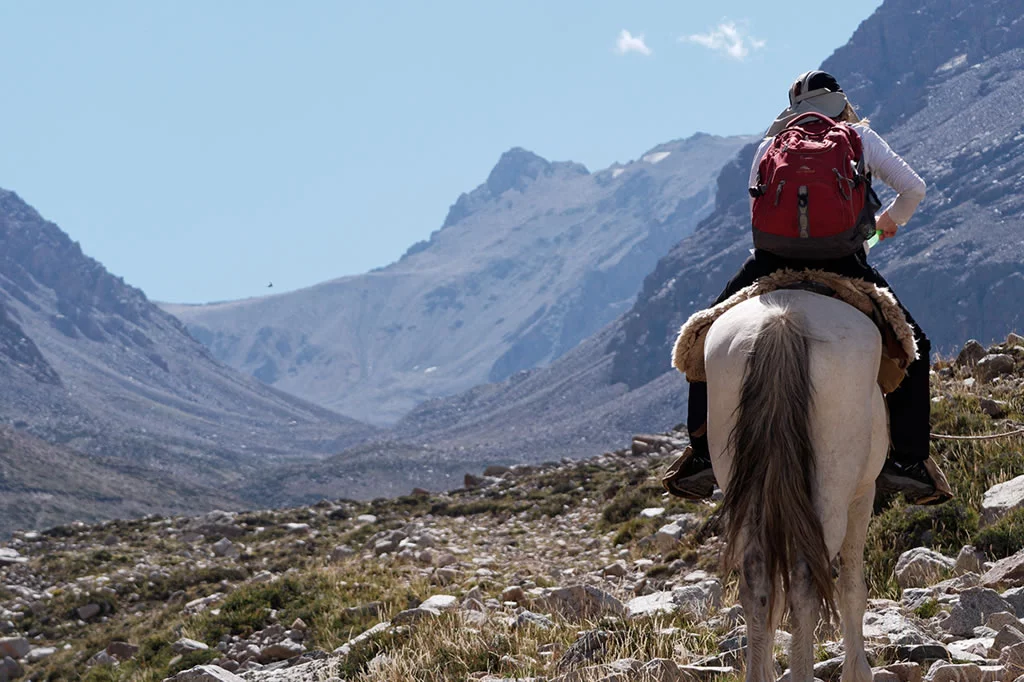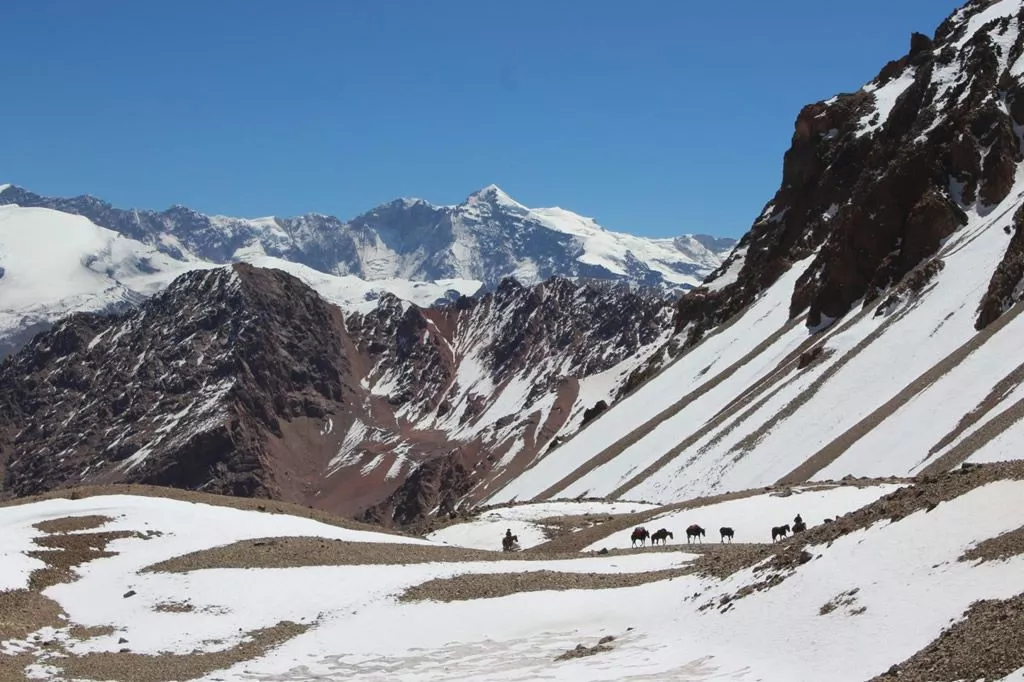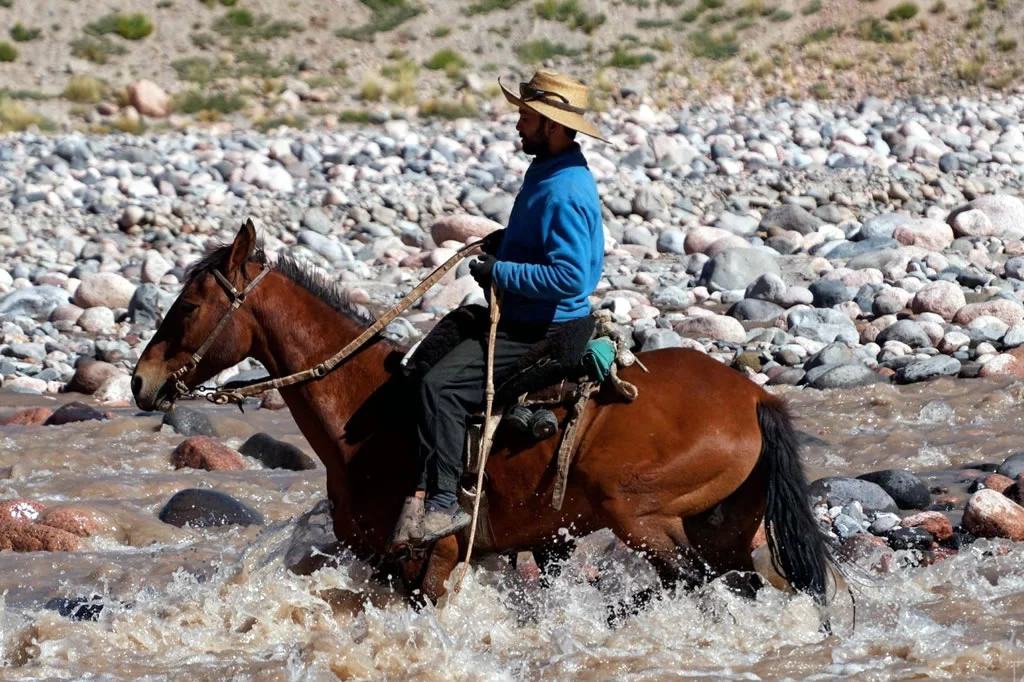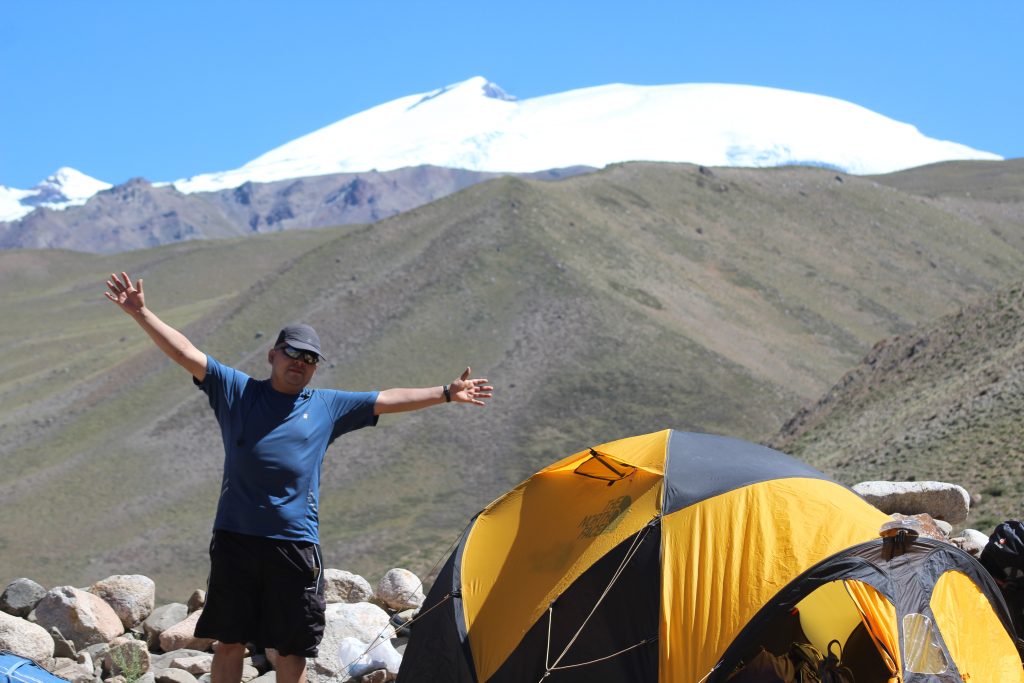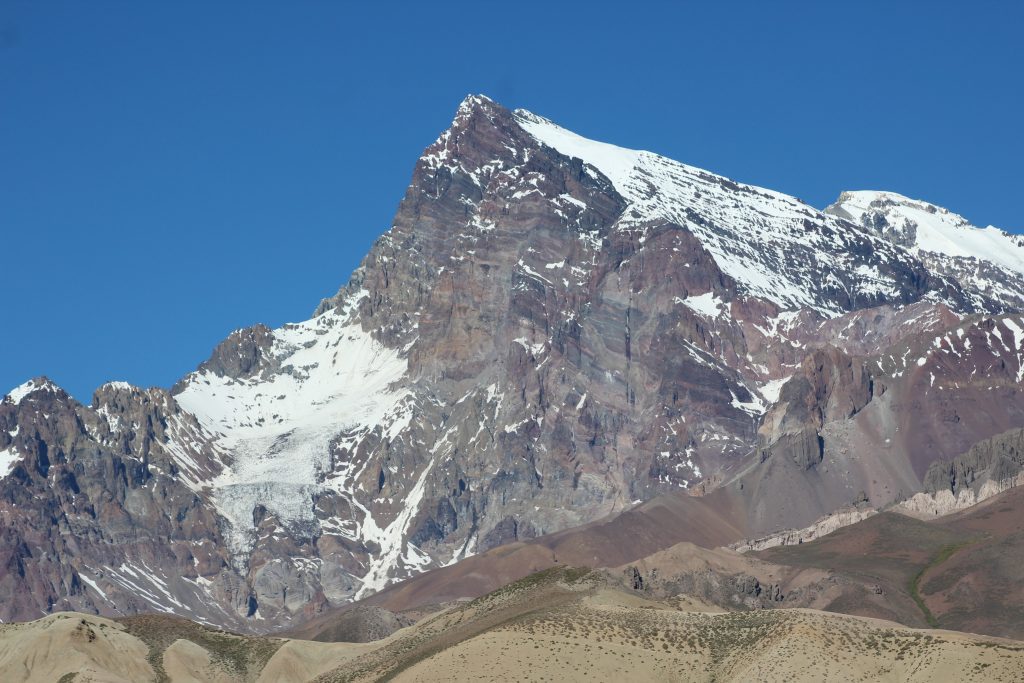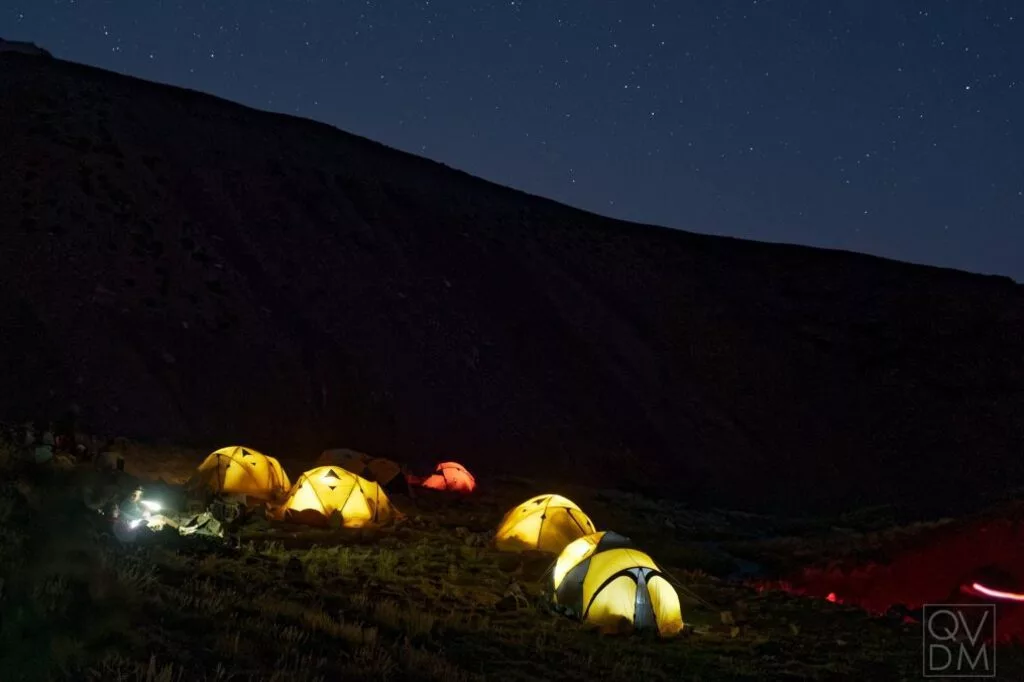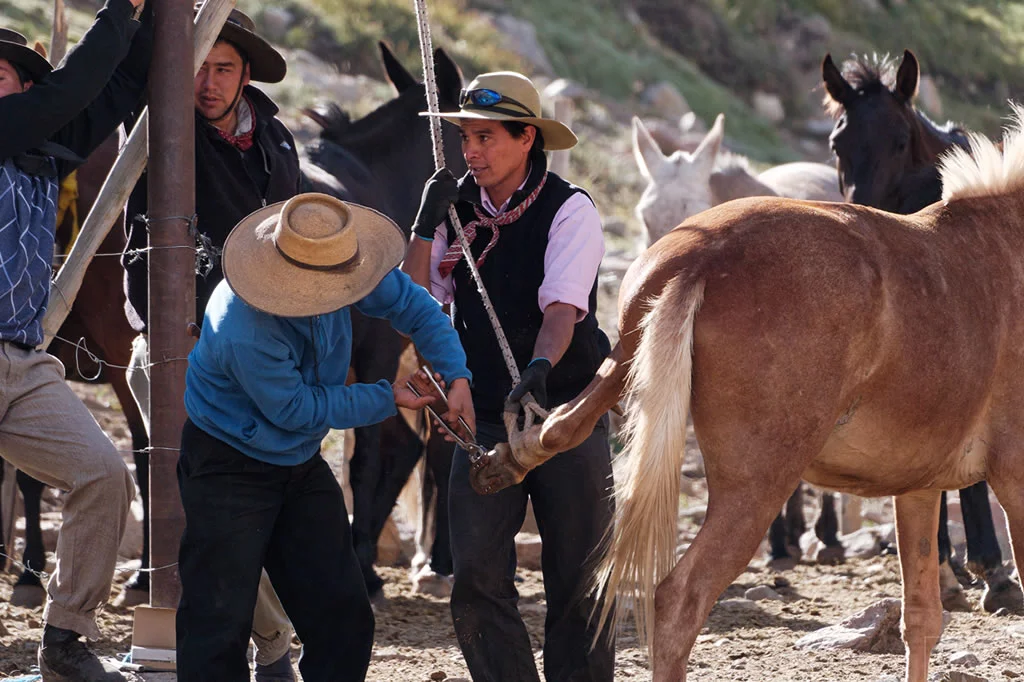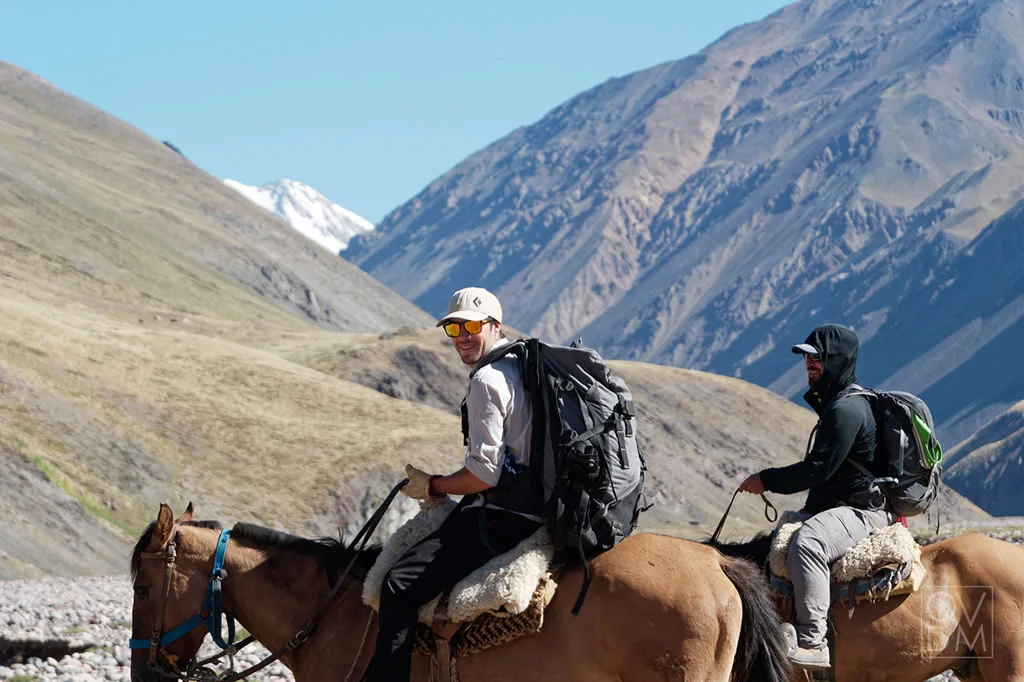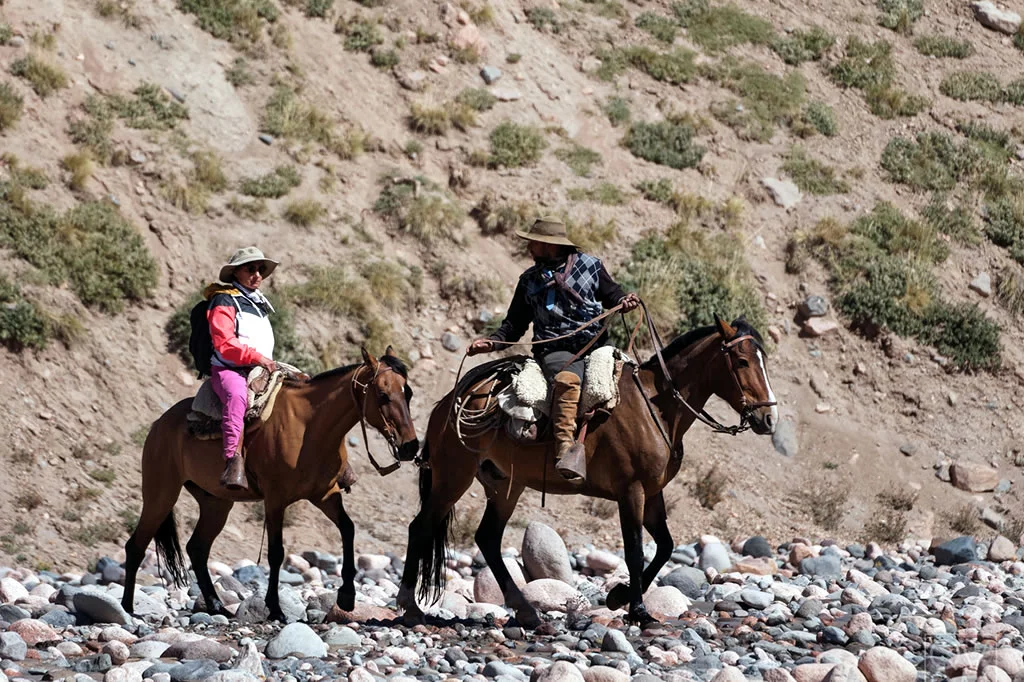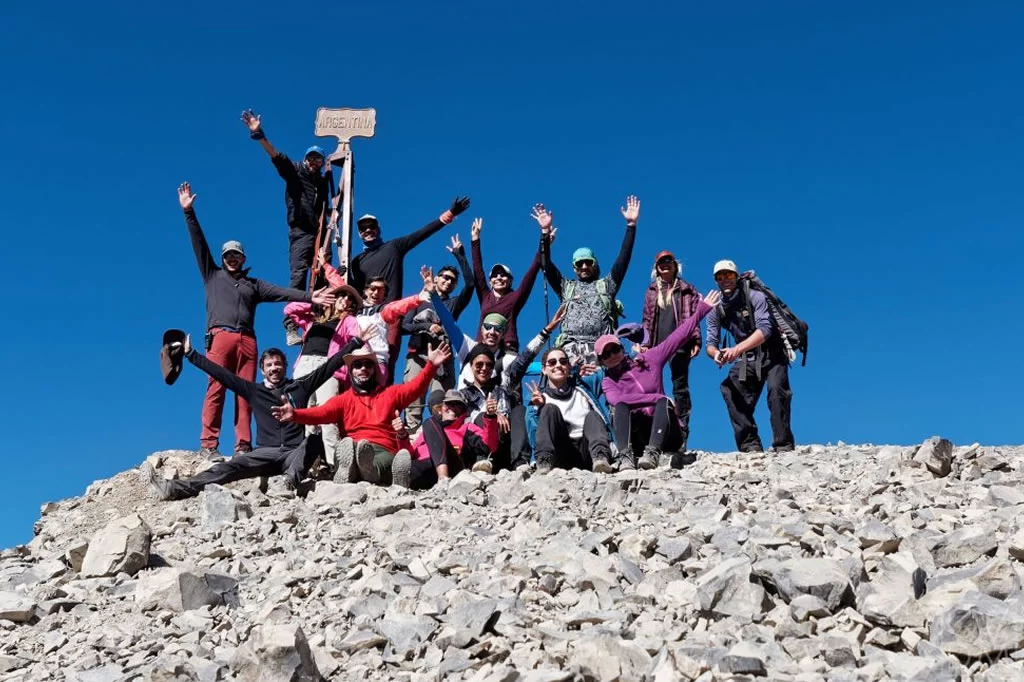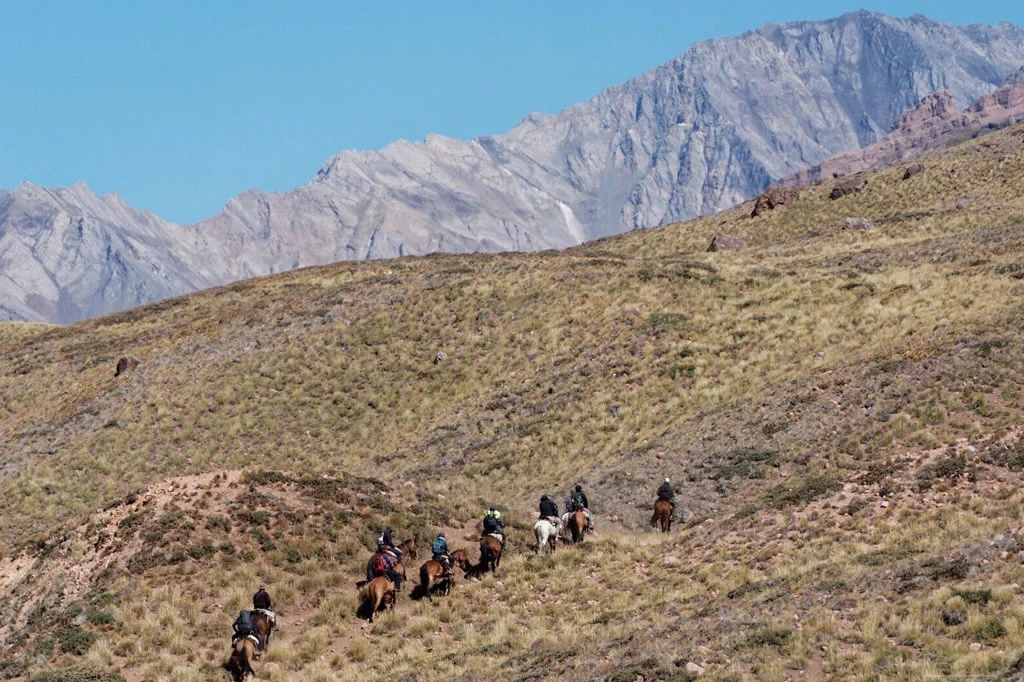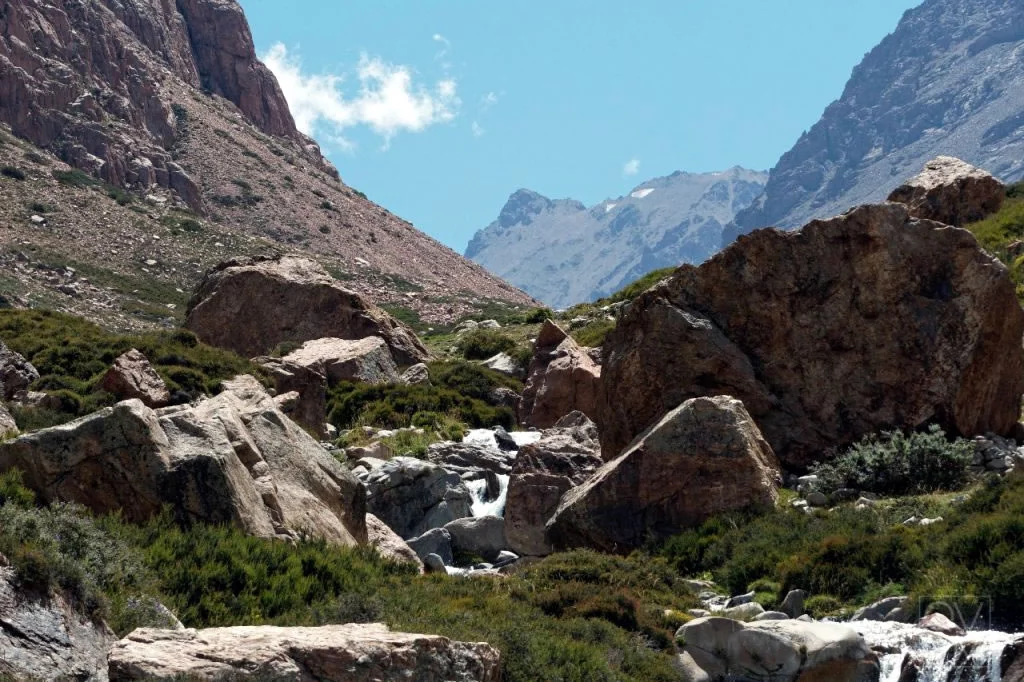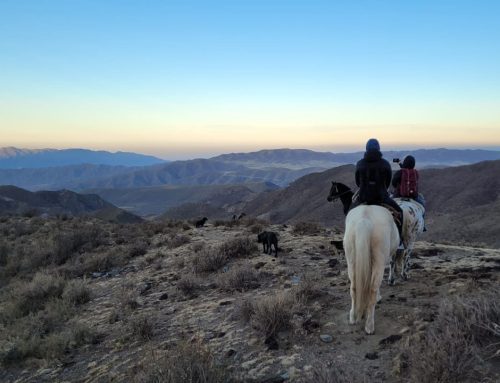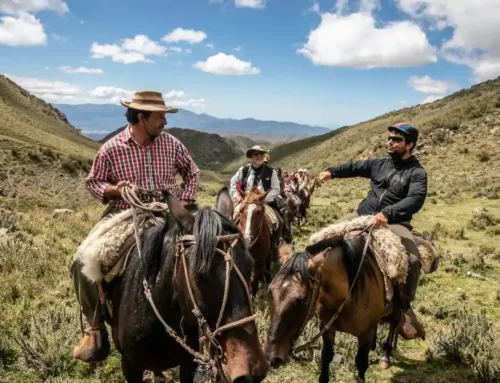Andes crossing on horseback via the Piuquenes Pass
Our Andes crossing on horseback is an unforgettable adventure. We guide you on a 7-day ride to relive a part of our history: we are going to cross the Andes through one of the passes used by the Army of the Andes in its liberation campaign.
The tour will begin in the Province of Mendoza. From there we will go into the mountains to reach the border with Chile, and we will finish the activity in Santiago de Chile city.
We will cross the border through the Portillo de Piuquenes International Pass, the same one that was used by General San Martin when he returned from his heroic feat in 1823. You will experience a week of horseback riding and camping in the middle of the imposing Andean landscape.
The experience of doing this every year -with many people- has given us the knowledge to provide a safe trip, and our human quality gives us the conviction that for each participant this will be a unique experience in their life. That is why we work with a lot of dedication to make you feel comfortable at all times and in an excellent group environment.
Professional guides guarantee that you will enjoy a safe tour, and you will also share the expedition with a group that will be walking. The itinerary will have some demanding days, while others will be for rest and recovery.
A must on all our expeditions: delicious meals to reward the effort of each day.
Who is this experience recommended for?
For those who enjoy outdoor adventures and want to get to know the Andes in depth.
You are not required to have great experience in horseback riding, but you do need to have physical agility and the ability to get on and off the horse. You will also need the strength to endure long days of riding, and the ease to traverse steep descents and uneven terrain without fear.
Why choose us?
- We are a certified service provider for the “Portillo de Piuquenes” reserve. (EX-2023-00869829-GDEMZA-).
- We offer fresh, quality meals every day, with tasty dishes adapted to all types of diets (meat, vegetarian, vegan, etc.).
- We work with a chain of reliable vendors (from muleteers to transportation) to guarantee a good experience from start to finish.
- You will be constantly advised by us: we will guide you in advance about the necessary equipment, itinerary, etc. Upon booking we will have an informative video call with you. And during the trip we will share valuable information about mountaineering, flora and fauna and history.
- We are professional guides, trained in First Aid in wild areas, with experience in mountaineering and emergencies.
- As a family company, we prioritize personal customer care and a good group environment.. There will be no lack of motivation, energy and dedication, because we are passionate about what we do.
- Group sizes are limited, to a maximum of 20 people. You will have 1 guide every 5 participants, in order to provide the necessary attention to each mountaineer.
About the Andes Crossing of 1817
In this tour with Destino Montaña, we are going to recreate the famous Crossing of the Andes, considered one of the greatest milestones in the world’s military history. was part of the plan devised by General José de San Martín to carry out the Liberation Expedition of Argentina, Chile and Peru.
San Martin, based in Mendoza since 1814, planned a three-stage campaign (continental, regional and local). The objective: to cross the Andes, liberate Chile and from there advance by sea towards Lima.
“What keeps me awake at night is not the opposition of my enemies, but rather the fact of crossing these immense mountains”.
Letter from San Martín to his friend Tomás Guido, June 14, 1816.
In January 1817 the Army of the Andes set out on this mission, divided into six columns. Each one would enter through a different pass: Comecaballos, Guana, Los Patos, Uspallata, El Portillo and Planchón. All of them had to reach a meeting point, from where they would organize to take Santiago de Chile.
The main column, led by San Martín, was the Paso de Los Patos column. The pass we will use, the Portillo pass, was used at that time by a small column of men led by Gen. José Leon Lemos. Its objective was to deceive the enemy, making them believe that they were the vanguard of the army (and that more troops would come from behind).
The timing of the plan was perfect, and with the final victory at the Battle of Maipú, the royalist army was definitively defeated, ensuring the independence of Chile.
Season 25/26:
- January 26: 11th to 16th.
- January 26: 25th to 31st.
- February 26: 15th to 21st.
- March 26: 15th to 21st.
- Professional Trekking Guide.
- Horse and saddle during the rides (from day 1 and from day 3 to 6).
- Satellite communication in case of emergency.
- First aid kit.
- General equipment (3-person tents, heaters, pots and pans).
- Full board for all 7 days (from lunch on day 1 to breakfast on day 7).
- Staff trained in wilderness first aid.
- Personal accident insurance (see conditions).
- Transportation from Mendoza to Portinari and from Río Plomo hot springs to Santiago de Chile.
- Mule transportation of general equipment and 10 kg (maximum) of personal equipment.
- Night in a hostel in Santiago de Chile (shared rooms).
- Advice on the purchase or rental of the equipment you will need.
- Saddlebag to carry your personal items on the horse.
- Transportation of your equipment from the border with Chile (milestone) to the city of Mendoza. In case you require it, we can also ship it to your home.
- Return of your rented equipment (if you rented it at the store we suggest).
Does not include
- Personal equipment.
- Equipment rental.
- Transfer to Mendoza or from Chile.
- Expedition abandonment or rescue costs (see FAQ).
- Transfer of personal equipment on the Chilean side.
- Horseback riding on the Chilean side (see FAQ).
- Shipping cost of your equipment from Mendoza city to your home address.
- Any other service not mentioned.
The land of sun and good wine welcomes you. This day you will have to prepare to rent the equipment in case you need it. It is important that you have everything ready in the afternoon, since between 6 and 8 p.m. we will come to your lodging to pick up the loads and prepare them for the next day. For the same reason, it is important that you stay within the downtown radius.
Day 1 – From Portinari to Scaravelli shelter.
A good start. We will pick you up from your lodging in downtown Mendoza, to move in vehicles to the Portinari shelter, where we will carry out all the customs formalities.We are in the Andes at last! From there we start the first horseback ride to the Scaravelli shelter, where we will spend the night and enjoy a delicious dinner.
Distance: 8 km- 4.9 mi / Elevation gain: 700 m – 2296 ft / Max. altitude: 3.200 masl/ Ride: 2 h.
Day 2 – A well-deserved rest at Scaravelli Shelter.
This day we are taking it easy: we will stay and have a good time in Scaravelli. Our guides will propose acclimatization activities in the surroundings – Manantiales area. Staying at the same altitude level is also a key point for acclimatization. Those who wish and feel well, will be able to do the acclimatization hike.
Day 3 – “La Olla” camp.Let’s get ready for our most intense day. We will wake up early for a nutritious breakfast and begin a 8-hour riding until we reach “La Olla” camp. The day is long because we have to go through a high pass: it will be necessary to climb up to 4,350 masl, and then descend to 3,300 masl, and reach a good place to camp and rest. On that day we will reach the maximum altitude of the whole expedition (4,300 masl), and we will have completed one of the longest challenges.
Distance: 22 km- 13 mi / Elevation gain: 1150 m – 492 ft/ Max. altitude: 4350 masl/ Ride: 8 h.
Day 4 – Tunuyán river with a view of Tupungato volcano, glaciers and “sixthousanders”.This day we will move to the “Contreras” camp. To do so, we will cross the great Upper Tunuyán River. The route gives us magical views of the south face of Tupungato, with majestic glaciers and hills of more than 6,000 m. We will enjoy a half day of rest in Contreras, a place with pleasant temperatures, ideal to recover from the previous day.
Distance: 8,5 km- 5 mi / Elevation gain: 200 m. – 656 ft /Max. altitude: 3250 masl / Ride: 3 h.
Day 5 – From Contreras to Gauchito Gil.We continue to make progress towards our goal. We will ride for approximately 4 hours until we almost reach the border crossing with Chile. As we advance, we will witness the immensity of the Andes, and we will be able to identify the mountains that can be seen from there, such as the Nevado de Piuquenes and Marmolejo. We will arrive at a point very close to our goal: the following day will be an important one. Let’s get ready!
Distance: 12 km- 7.45 mi / Elevation gain: 250 m. – 820 ft / Max. altitude: 3300 masl / Ride: 4 h.
Day 6 – Internacional pass “Portillo de Piuquenes”. Our milestoneWe start early and with excitement: we approach our objective. We will leave at dawn, and around noon we will reach the border crossing with Chile, we will have made it!
After the celebrations and photos, our reward: the hot springs of “Plomo”. We will arrive on foot, because it is not allowed to cross the border with animals. After a great descent on foot of 3 hours and 1,100 meters of negative slope, we arrive at the hot springs to recover from the journey. There we will enjoy two essential things: a good reception and our well-deserved toast. Finally, our transfer will pick us up to take us to Santiago de Chile.
Distance: 11 km- 6.8 mi / Elevation gain: 750 m. – 2460 ft / Max. altitude: 4100 masl / Ride: 6 h.
Day 7 – farewell in Santiago de Chile.Upon waking up, we will share breakfast, so that everyone can prepare and start their return trip. We will say goodbye with all the satisfaction and happiness of the days we will have lived. Looking forward to our next adventure together!.
Important: Those who wish to return by bus to Mendoza with our staff, should take into account that we take the 10:30 a.m. bus of the company “Andesmar”, at the station in Santiago de Chile. And if you are coming back by plane, we do not recommend you to buy a return ticket very early, as you will wake up very tired
Why are there some routes that are done on foot, and not on horseback?
On day 2, because it is important to acclimatize to the altitude, and the best way to do it is to put our body in motion. The expedition involves a great difference in altitude, which we are not used to on a daily basis: we will go over 4,000 meters above sea level. Therefore, physical activity helps our body to accelerate its adaptation mechanisms, and can prevent “altitude sickness” (discomfort, headache, or dizziness).
On day 6 we will walk downhill for 3 hours, because it is not allowed to enter Chile with animals. This will be 5 km. and 1,100 meters of negative slope.
Is it necessary to have experience in horseback riding?
It is not essential that you have great experience, but it is necessary that you are used to the animals, and have a physical condition that allows you to complete long days of horseback riding. You will need agility and strength to get on and off the horse. The expedition requires psychomotor skills and the ability to ride without fear on uneven terrain (with steep slopes). How to prepare? We suggest doing physical activity of intermediate intensity, 40-45 min., 3 times a week. We recommend speaking to a professional about this.
What will the weather and temperatures be like?
Temperatures can be extreme and variable: in the same day it is possible to have temperatures ranging from -10 C° to 25 C° (14 ºF to 77 ºF). The sun is very intense and wind gusts can reach 70 km per hour. We can also expect to encounter snow, so the equipment you carry should be optimal for the different weather conditions.
What are the camps like?
They are 100% wild: they have no infrastructure whatsoever. You will not be able to bathe (unless you bathe in a stream), nor will you have a place to wash your clothes.
How many people sleep in a tent?
Three people will sleep in each tent. The logistics are planned in this way for reasons of organization and time, since we will have to set up and dismantle the camp daily.
How many guides are coming?
There is 1 guide for every 4/5 people. It is the ideal number to provide a fully personalized service, and ensure the best care to the adventurers.
What to expect from the full board?
We offer breakfast, afternoon snack, lunch, dinner and trail snacks every day. The only exceptions will be day 1 (which starts with the trail lunch), and day 7 (which includes breakfast only).
The menu is prepared according to the logistics and activity planned for each day.
Some of the foods included may be: barbecue; pasta with meat sauce; homemade bread sandwich, cold cuts, tomato and avocado; stew; soup; fresh fruit; nuts; cereal bars; oatmeal cookies; etc.
Do you offer a menu that is vegetarian/ adapted to dietary restrictions?
Of course. We will prepare something special for you. Just let us know upon booking.
Will I be able to communicate and charge my cell phone?
You will not be able to communicate by cell phone (or by any other means), as there is no phone signal or wi-fi along the entire route. You will not be able to charge it either, as there is no electricity. However, we recommend that you carry a Power Bank that can provide 3 full charges for your cell phone, and that you keep it in airplane mode.
How is my personal equipment transported?
Personal equipment (weighing up to 10 kg./ 22lb) will be transported on mules. Keep in mind that it may deteriorate due to the service of the loads. That is why we recommend renting a mule bag.
What do I do with my equipment when I reach the milestone?
When crossing the border, mules will not be allowed to enter into Chile (by legal provision).
We offer you to send your equipment back with the muleteers to Manzano Histórico.
Then, we will take care of transporting it to Mendoza City, and we will be able to:
- Return the rented items (only in case you have rented at the rental house we suggest), and deliver your belongings to your accommodation in Mendoza free of charge, the day after the end of the activity.
- Send your belongings to any place in Argentina (in this case you will have to pay an extra shipping cost from Mendoza city to your home address). This service has a delay of 10 to 15 days, and you must previously provide us with a labeled bag of your property to be able to make the shipment.
In either case, you must let us know in advance.
Another alternative is to take care of your own load down a demanding slope for 3 hours from the border to the Río Plomo hot springs, where the transfer will be waiting for us (to go to Santiago de Chile), but we do not recommend this option.
However, if you are interested in carrying your equipment in this way, you must let us know before the expedition so that we can evaluate it.
How does the activity end?
It ends in Santiago de Chile on day 7, after breakfast at the hostel where we will have slept the previous night. The return trip is not included in the service. You will have the following options:
- Taking a plane to your city/country of residence.
- Returning to Mendoza by bus (we can help you to arrange the ticket).
On day 7 in the morning the staff takes the Andes Mar bus at 10.30 am. If you choose this option and then need to take another transport to your city, we recommend doing it the next day. Due to border procedures, the bus may take some time to get to the city, with the risk of losing your return ticket in case it is at night. The cost of the bus is approximately 50 USD. - If there are more than 8 of us returning to Mendoza, we can hire private transportation (van) to return together. Ask us at the time of booking.
How do I book the activity?
The activity is booked with a bank transfer corresponding to a part of the total amount. This way the price is fixed and you can secure your place. The remaining amount must be paid days before the beginning of the adventure. Contact us to know the terms and conditions of the reservation and cancellation policies.
Can the itinerary change?
Yes, the itinerary is an ideal and approximate planning. However, it will be subject to climatic and human contingencies. Therefore, in order to improve the chances of reaching the milestone or to preserve the safety of the group, our professional guides may make decisions that change the planned itinerary. This can happen at any time and without prior notice.
When to get to Mendoza and where to stay?
You should arrive in Mendoza the day before the activity starts. If you need to rent equipment, you will need to arrive in the morning.
It is very important that your accommodation is located within the downtown radius. Because the day before, between 6 and 8 p.m. we will pick up the mule bag and some documents that are required to enter the park. Then, on day 1, we will pick you up for the beginning of the activity between 8 and 9 a.m. We will only be able to do so if your accommodation is within that radius.
Important: if you are not staying in the downtown radius, it will be your responsibility to take care of the logistics as well as the cost of transportation. If you do not arrive downtown on time to deliver your equipment and documents on day 0, you will have to bring them to our offices.
Should I have a medical check-up?
We strongly recommend that you take a physical stress test, so that a professional can evaluate your cardiovascular health. That way you will be sure that you will be able to complete the most physically demanding days without any risk.
What am I exposed to in this activity?
If you have no experience in mountaineering, it is important that you know that:
- The Andes have a hostile climate, and the itinerary is quite demanding on some days. You will need to learn to protect yourself from the sun, drink water regularly, get used to the uneven and rocky terrain, and the lack of comfort in general.
- Services in the camps are basic, and the staff cannot attend to all your particular needs. So you will have to be patient and self-sufficient in many things.
- Due to the high risk of the mountain weather, the requested equipment is mandatory. It is common to underestimate the weather conditions, but you have to know that they are adverse, and prepare yourself psychologically to face them.
What costs do I incur if I abandon the activity itinerary?
Costs may vary depending on the point at which you abandon, and the services you need.
The most important thing to know is that all expenses for rescue or abandonment of the activity must be paid by the participant, as we do not include them in our service. However, we will accompany you throughout the process and in the event of a serious emergency we will make all our resources available to take care of your health.
The costs you may incur are:
- If you descend from “Scaravelli” to Mendoza, the cost of this service can reach up to 280 USD.
- If you use the horse to go as far as where the van is, the cost is variable and will depend on how many days you need it, but it can cost up to 80 USD per day.
- If you descend from the milestone to the Chilean side, the cost of the animals and muleteer for a single day is up to 400 USD.
All these costs are from service providers that are not part of Destino Montaña, so you must have enough cash available to pay them on a daily basis, as you hire the services.




